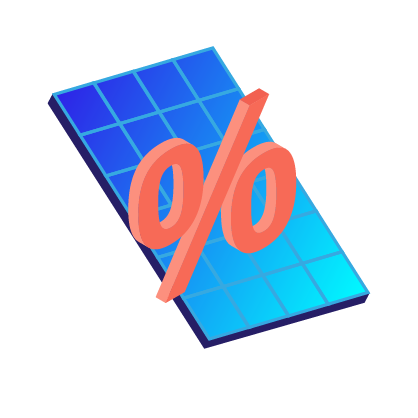How Many Solar Panels Does It Take To Charge an EV?
Solar panels and electric vehicles (EVs) go together like peanut butter and jelly, Batman and Robin, and peas and carrots. Charging an EV on solar is cheap, clean, and convenient, but exactly how many solar panels does it take to charge an EV?
The answer depends on a few things like solar panel production, EV battery and efficiency, and your driving habits. But with a few assumptions and a little math, you can get a ballpark idea of how many solar panels you’ll need to charge an EV.
In this article, we’ll walk through how to make these calculations and show how much you can save by charging an EV on solar.
Let’s start by getting a sense of how much energy it takes to charge in EV.
How much energy does it take to charge an EV?
First, we’ll need to put a number on how much electricity your EV will use per day.
To get this, we’ll need the number of miles traveled per day (the national average is 37) and the fuel efficiency rating of the EV. There are a few different fuel efficiency measurements for EVs, here’s what you might come across when researching:
- Miles per gallon equivalent (MPGe)
- Kilowatt hours per 100 miles (kWh/100 miles)
- Miles per kWh (Mi/kWh)
The third rating, miles per kWh, is the easiest to work with for our purposes.
If you can’t find it, simply take the MPGe (which the Environmental Protection Agency provides for all EVs) and divide it by 33.705.
MPGe / 33.705 = mi/kWh
So let’s use the super popular Tesla Model Y Standard Range RWD as an example, which gets 129 MPGe or 3.82 miles per kWh, and will likely to eligible for the $7,500 new EV tax credit beginning in 2023.
Now that we have an efficiency rating, we simply divide the miles traveled per day by the number of miles a Tesla Model Y can travel per kWh.
37 miles per day / 3.82 miles per kWh = 9.69 kWh per day
This figure is the average amount of energy a Tesla Model Y uses per day and how much solar capacity the driver needs to keep it charged. Next, let’s see how many solar panels it takes to generate 9.69 kWh of electricity per day.

Related reading: Hyundai IONIQ 5 Charging Costs: Solar Versus Utility
How many solar panels do you need to charge an EV?
The short answer is it takes anywhere between 5 and 12 solar panels to charge an EV, but it depends on so many factors. Let’s keep going with our Tesla Model Y scenario to see how it plays out.
We know we need 9.96 kWh of electricity a day to charge, so now we can work backward to find out how many solar panels it takes to generate that amount of electricity.
First, let’s figure out how many kWh of electricity a single panel can produce per day. This is number varies based on the wattage of the panel and the hours of daylight it receives per day, but the formula is very simple.
Hours of daylight per day x wattage = Watt-hours per day
Divide Watt-hours by 1,000 to get kilowatt hours (kWh) and you now have the daily output of a solar panel.
Solar panel outputs range from 250 to 400 Watts, but these days it’s pretty rare for an installer in the solar.com network to offer anything less than 360 Watts. In fact, 400W is now considered standard. But let’s use a 360W panel as our baseline just to be conservative.
The average number of sun hours per day ranges from 3.5 to 6 in the US, but most of the country averages 4.5 hours a day or more. We’ll use with 4.5 to be conservative.
4.5 hours of sun per day x 360 Watts = 1,620 Watts per day, or 1.62 kWh per day
Now we know how much electricity each panel produces we can figure out how many panels it takes to charge a Tesla Model Y travelling 37 miles a day. We’re one equation away from finding out how many solar panels it takes to charge an EV!
Finally, divide the kilowatt hours of electricity needed by the daily kWh output of each panel to get the number of panels needed to charge.
9.69 kWh per day / 1.62 kWh per panel per day = 5.98 panels
Since we can’t have a partial panel, we round up to find you’d need six 360-watt panels getting 4.5 hours of sun per day to charge a Tesla Model Y that travels 37 miles per day.
Everyone’s solar EV charging situation is different
As you can see, the exact number of panels it takes to charge an EV depends on four major factors:
- Fuel efficiency of the EV
- Number of miles traveled per day
- Wattage of the solar panels
- Average hours of sun per day
Let’s run through some more scenarios to see how the numbers change. First, we’ll tweak the fuel efficiency of the EV to see how that changes the number of panels needed by comparing the very efficient Tesla Model Y with the terribly inefficient 2014 Toyota RAV4 EV.
*Figures are rounded up to the next whole panel.
| EV model | Miles per day | Fuel efficiency (mi/kWh) | Panel wattage | Sun hours per day | Number of panels needed* |
| Tesla Model Y | 37 | 3.82 | 360 | 4.5 | ~6 |
| 2014 Toyota RAV4 EV | 37 | 2.17 | 360 | 4.5 | ~11 |
Now let’s tweak panel wattage by comparing high and low output panels. Keep in mind, 400W panels have become standard, and it is rare for installers in the solar.com network to offer anything below 360W.
| EV model | Miles per day | Fuel efficiency (mi/kWh) | Panel wattage | Sun hours per day | Number of panels needed* |
| Tesla Model Y | 37 | 3.82 | 400 | 4.5 | ~6 |
| Tesla Model Y | 37 | 3.82 | 250 | 4.5 | ~9 |
| 2014 Toyota RAV4 EV | 37 | 2.17 | 400 | 4.5 | ~10 |
| 2014 Toyota RAV4 EV | 37 | 2.17 | 250 | 4.5 | ~16 |
Finally, let’s tweak the number of sun hours a day to compare charging a Tesla Model Y in New York, a great state for solar incentives, versus Arizona, a great state for sun exposure.
| Location/EV Model | Miles per day | Fuel efficiency (mi/kWh) | Panel wattage | Sun hours per day | Number of panels needed* |
| New York/Tesla Model Y | 37 | 3.82 | 360 | 4.2 | ~7 |
| New York/RAV 4 | 37 | 2.17 | 360 | 4.2 | ~12 |
| Arizona/Tesla Model Y | 37 | 3.82 | 360 | 5.5 | ~5 |
| Arizona/RAV 4 | 37 | 2.17 | 360 | 5.5 | ~9 |
When it comes to charging an EV with solar panels, everyone’s situation is different. But there is one constant: charging an EV with solar is the cheapest available option.
Let’s explore that a little further.
Why charge an EV with solar panels?
One of the primary benefits of driving an EV is that you can control your fuel costs. Unlike combustion vehicle drivers, who are limited to gas stations, EV drivers have at least three options for charging:
- Public chargers
- Grid power at home
- Solar power at home
Solar power is the cheapest charging option by a long shot. In fact, charging at home on solar power costs about half as much as charging on grid power, and five times less than fueling an EV at public chargers or a combustion car with gas.
That’s because the average price per solar energy purchased through solar.com (6-8 cents per kWh) is about less than half the national average price of grid energy (16.6 cents per kWh).
Cost of solar EV charging versus other fueling options
| CHARGING METHOD | SOLAR POWER | GRID ENERGY | PUBLIC CHARGER | 30 MPG COMBUSTION CAR |
| Miles per unit of fuel | 3.33 miles per kWh | 3.33 miles per kWh | 3.33 miles per kWh | 30 miles per gallon |
| Distance per year | 13,476 miles* | 13,476 miles | 13,476 miles | 13,476 miles |
| Fuel per year | 4,047 kWh | 4,047 kWh | 4,047 kWh | 450 gallons |
| Cost of fuel per unit | $0.08 per kWh | $0.166 per kWh | $0.40 per kWh | $3.96 per gallon |
| Total fuel cost per year | $323.75 | $671.77 | $1,618.40 | $1,777.04 |
*Based on data from the US Department of Transportation
Solar power is already the cheapest option for many homeowners and that difference will only grow each year as the prices of grid energy and gasoline increase. Here’s solar EV charging looks compared to grid and gas over 25 years.
 Over 25 years of charging an EV on solar, the average driver would spend roughly $4,000 less than if they charged on grid energy and nearly $70,000 less than if they drove a combustion vehicle getting 30 mpg.
Over 25 years of charging an EV on solar, the average driver would spend roughly $4,000 less than if they charged on grid energy and nearly $70,000 less than if they drove a combustion vehicle getting 30 mpg.
And that’s not to mention that solar charging is the cleanest and most convenient way to charge an EV.
Think about tomorrow today
Whether you already have solar panels before you get an EV or you get an EV before you have solar, give some serious consideration to adding the solar capacity you need to charge your EV.
Although the upfront cost is a hurdle, the long term savings of charging an EV with solar is well worth it and there are new and improved tax credits in the Inflation Reduction Act that can help reduce the cost of solar, battery, and electric vehicles.
When it’s all said and done, you’ll be charging your EV in the cheapest, cleanest, and most convenient way possible!











